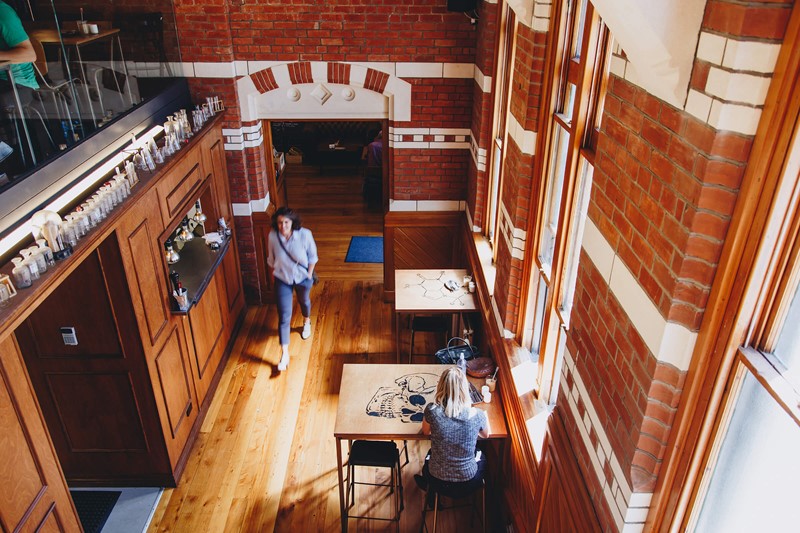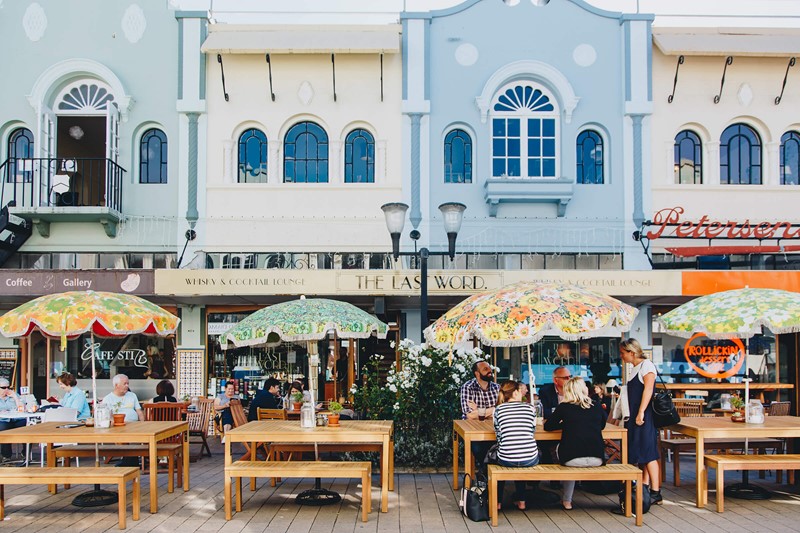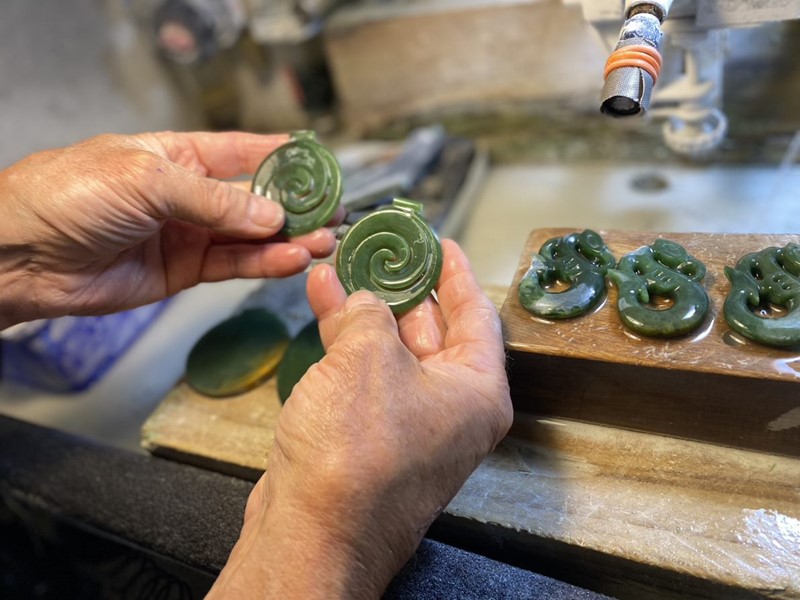Where’s The Best Place To See Pounamu In The South Island?
ChristchurchNZ catches up with lead guide Riwai Grace, of Āmiki tours, to find out.
It’s a bright, sunny Saturday afternoon when we meet Āmiki tour guide Riwai Grace in the courtyard of the Christchurch Arts Centre on Worcester Street.
The Ōtautahi local (of Ngāti Porou, Te Whānau-ā-Apanui, Ngāi Tahu and Pākehā descent) is taking us on a walking tour of the city.
Over three hours we’ll walk the CBD, visiting various pounamu kōhatu (stones) that help tell the story of the city and its cultural ties to the people and rivers of the West Coast, snacking as we go.
The first stop is Bunsen cafe for coffee, though the only pounamu on show is the stunning green and yellow greenstone breastplate hanging around Riwai’s neck.

“This piece is from the West Coast’s Arahura River,” he says, offering it up for a closer look.
The Arahura River, near Hokitika, is one of New Zealand’s most important pounamu yielding rivers, Riwai explains.
His piece was a gift from wife and fellow Āmiki director and tour guide, Cate, on their wedding day.
The Ngāi Tahu couple (Cate’s ancestors whakapapa to Christchurch’s Kaiapoi pā) gave pounamu pendants sourced from South Island greenstone to their wedding party, as well as a handful of lucky loved ones.
“Those pieces have since spread across the motu and yet tie the wearers to this place and to our special day. That, to me, is what gifting pounamu is all about,” says Riwai.
Walking towards the historic Antigua Boatsheds, we cross the bridge to check out Ngā Whāriki Manaaki, a series of 13 artworks embedded into the footpath as part of the Ōtākaro Avon Arts Trail, on the other side.

Standing beside the first in the series, Paepae Pounamu – Ngāi Tahu, Riwai points out the handful of pounamu squares within the intricately designed piece and explains what it’s about.
“It’s a kind of welcome mat for visitors to Christchurch, extended by Ngāi Tahu, principal iwi of Christchurch and Te Waipounamu and the legal guardians or kaitiaki of all New Zealand greenstone. It draws on the Māori cultural practice of welcoming you onto the paepae or orator’s bench of a marae.”
Riwai says people on his tours, mostly Kiwis so far, are becoming more open to stories about New Zealand’s history beyond the colonial narratives commonly told.
Post-earthquake, Christchurch is an ideal city for that.
As we continue walking, it’s possible to see each artwork resemble a woven mat, creating a visual trail all the way down the promenade to the popular Margaret Mahy Family Park.
Before grabbing a tub of sweet caramel gelato from Rollickin Desserts Cafe on New Regent Street, we visit several more important sites, featuring both pounamu kōhatu and the stories associated with them.

At Oi Manawa (meaning tremor or quivering of the heart), the Canterbury Earthquake National Memorial on the South Bank, we place our hands on the smooth surface of a large 270 kilogram kōhatu by carver Fayne Robinson.
Riwai explains it was sourced in South Westland and gifted by Te Rūnanga o Makaawhio (a Ngāi Tahu sub-tribe) to remember the 2010 and 2011 earthquakes, as well as the Māori tradition of placing pounamu at important entranceways.
“If you touch this pounamu, like I do walking to and from the office every day, it connects you back to the whenua. I really believe that,” says Riwai before we move on.
At Ngā Māra a Te Wera (The Gardens of Te Wera), a landscaped courtyard surrounded by office buildings on Hereford Street, there’s another kōhatu.
This time it’s part of a series of artworks and storyboards setting out the site’s cultural, historical and spiritual significance to Ngāi Tahu and the city’s European, police and military heritage.
Then, as the afternoon sun starts to lower in the sky, Riwai leads the way to Market Square, a popular marketplace for early Māori, also known as Victoria Square in reference to the city’s colonial roots.
We marvel at the six-metre high poupou, carved from totara by master carver Riki Manuel, which references the site’s history as part of Puari pā, before wandering off to Cathedral Square.
Here, we take time to read the memorial to the city’s first settlers and a more recent plaque about the principal Māori settlements in Canterbury. The new shiny black memorial touches on the waves of iwi migration to the region and the purchase of the South Island by the New Zealand Company in 1848.
The sun is threatening to disappear by the time the tour is finished and we’re seated outside Riverside Market devouring noodles and souvlakis.
“It amazes me just how right they’ve got the rebuild of the city,” says Riwai. “Twelve or 13 years ago this was very much an English city. Now, you have another story that runs through it. To me, seeing Ōtautahi through both Māori and European eyes is an awesome thing.”
Did You Know?
Ngāi Tahu are the legal kaitiaki (guardians) of New Zealand greenstone. They are the only people in New Zealand legally permitted to take pounamu from West Coast rivers where it is found. As kaitiaki, they authenticate pounamu, buy greenstone sourced as a byproduct of mining, sell it to registered carvers and sell and market products made from New Zealand greenstone online and in stores throughout the country.

Where Can I Go On The West Coast To Learn More?
- To get to Greymouth from Christchurch, jump aboard the TranzAlpine, which travels from east to west (and back again) just like traditional pounamu traders used to do on foot. Buy a pounamu keepsake made from authenticated Ngāi Tahu greenstone to complete your trip.
- From Greymouth, travel south to Hokitika to meet local carvers. Traditional Jade is a family-owned business with ties to Ngāi Tahu. Pop in to see pounamu jewellery being made. Buy directly from the store or purchase a piece online. Carver Garth Wilson Jade’s studio on Rutherglen Road is another good place to visit. Garth descends from a long line of pounamu traders and today holds customary rights to hunt for pounamu on the West Coast.
- Walk the Arahura River with an experienced guide from Te Rua & Sons Pounamu Trails. Based in Hokitika, the whānau-run business takes visitors up river to hear traditional stories about pounamu and find pounamu in its natural environment.
What Else Can You Do As A Tourist?
You can support Ngāi Tahu by buying authenticated pounamu products and following the rules of fossicking: look for pounamu on the shores between Greymouth and Milford Sound and take only pebbles and stones.


